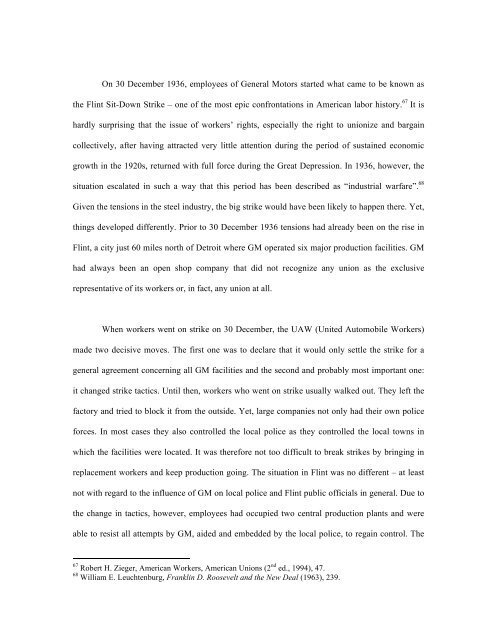Jasper Finke, Crisis and Law - New York University School of Law
Jasper Finke, Crisis and Law - New York University School of Law
Jasper Finke, Crisis and Law - New York University School of Law
Create successful ePaper yourself
Turn your PDF publications into a flip-book with our unique Google optimized e-Paper software.
On 30 December 1936, employees <strong>of</strong> General Motors started what came to be known as<br />
the Flint Sit-Down Strike – one <strong>of</strong> the most epic confrontations in American labor history. 67 It is<br />
hardly surprising that the issue <strong>of</strong> workers’ rights, especially the right to unionize <strong>and</strong> bargain<br />
collectively, after having attracted very little attention during the period <strong>of</strong> sustained economic<br />
growth in the 1920s, returned with full force during the Great Depression. In 1936, however, the<br />
situation escalated in such a way that this period has been described as “industrial warfare”. 68<br />
Given the tensions in the steel industry, the big strike would have been likely to happen there. Yet,<br />
things developed differently. Prior to 30 December 1936 tensions had already been on the rise in<br />
Flint, a city just 60 miles north <strong>of</strong> Detroit where GM operated six major production facilities. GM<br />
had always been an open shop company that did not recognize any union as the exclusive<br />
representative <strong>of</strong> its workers or, in fact, any union at all.<br />
When workers went on strike on 30 December, the UAW (United Automobile Workers)<br />
made two decisive moves. The first one was to declare that it would only settle the strike for a<br />
general agreement concerning all GM facilities <strong>and</strong> the second <strong>and</strong> probably most important one:<br />
it changed strike tactics. Until then, workers who went on strike usually walked out. They left the<br />
factory <strong>and</strong> tried to block it from the outside. Yet, large companies not only had their own police<br />
forces. In most cases they also controlled the local police as they controlled the local towns in<br />
which the facilities were located. It was therefore not too difficult to break strikes by bringing in<br />
replacement workers <strong>and</strong> keep production going. The situation in Flint was no different – at least<br />
not with regard to the influence <strong>of</strong> GM on local police <strong>and</strong> Flint public <strong>of</strong>ficials in general. Due to<br />
the change in tactics, however, employees had occupied two central production plants <strong>and</strong> were<br />
able to resist all attempts by GM, aided <strong>and</strong> embedded by the local police, to regain control. The<br />
67 Robert H. Zieger, American Workers, American Unions (2 nd ed., 1994), 47.<br />
68 William E. Leuchtenburg, Franklin D. Roosevelt <strong>and</strong> the <strong>New</strong> Deal (1963), 239.
















